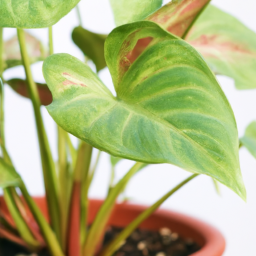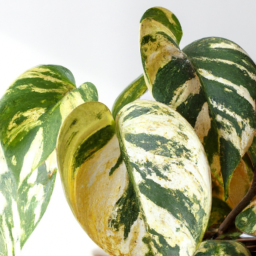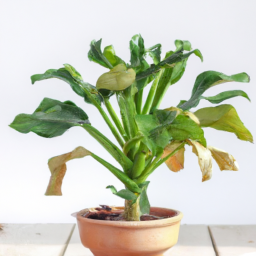
Are you looking to add some greenery to your home but don’t have the greenest thumb? Don’t worry, we’ve got you covered! In this blog post, we’ll be discussing the easiest house plants to care for. Whether you’re a seasoned plant parent or a beginner looking to bring some life into your space, these low-maintenance plants are perfect for anyone looking to add a touch of nature to their home without the stress of constant upkeep. Let’s dive in and explore some of the best options for those who want to enjoy the benefits of house plants without all the fuss.
Benefits of Low-Maintenance House Plants
Introduction
House plants are a great way to bring a touch of nature into your home, but not everyone has a green thumb. If you’re looking for low-maintenance house plants that are easy to care for, you’re in luck! There are plenty of options that require minimal attention and still look beautiful in your space. In this article, we’ll explore the benefits of low-maintenance house plants and provide you with a guide on how to care for them.
Benefits of Low-Maintenance House Plants
Low-maintenance house plants offer a variety of benefits that make them a great choice for busy individuals or those who are new to plant care. One of the main benefits is that they require minimal attention, making them perfect for people who don’t have a lot of time to dedicate to plant care. These plants are also more forgiving when it comes to watering and light requirements, so you don’t have to worry about constantly monitoring their needs.
In addition to being easy to care for, low-maintenance house plants can also improve the air quality in your home. Plants naturally filter the air by removing toxins and releasing oxygen, which can help create a healthier indoor environment. Some low-maintenance house plants, such as snake plants and spider plants, are known for their air-purifying properties and can help reduce indoor pollutants.
Another benefit of low-maintenance house plants is that they can help reduce stress and improve your overall well-being. Studies have shown that being around plants can have a calming effect and help lower blood pressure and anxiety levels. Having greenery in your home can also boost your mood and increase productivity, making low-maintenance house plants a great addition to any space.
Overall, low-maintenance house plants are a great choice for anyone looking to add some greenery to their home without the hassle of high-maintenance plants. With their easy care requirements and numerous benefits, these plants are a perfect option for both experienced plant parents and beginners alike.
How to Care for Low-Maintenance House Plants
Caring for low-maintenance house plants is simple and straightforward, making them a great option for anyone looking to add some greenery to their home. Here are some tips on how to care for these easy-to-maintain plants:
1. Watering: Low-maintenance house plants typically require less frequent watering than other plants. It’s important to let the soil dry out between waterings to prevent overwatering, which can lead to root rot. Check the soil moisture level by sticking your finger into the soil – if it feels dry, it’s time to water. Be sure to use room temperature water and water the plant thoroughly until water drains out of the bottom of the pot.
2. Light: Most low-maintenance house plants prefer bright, indirect light, but they can also tolerate lower light conditions. Place your plants near a window where they can receive plenty of natural light, but be careful not to expose them to direct sunlight, which can cause their leaves to burn. If your plant starts to look leggy or pale, it may need more light.
3. Soil and Fertilizer: Use a well-draining potting mix specifically designed for indoor plants when repotting your low-maintenance house plants. Fertilize your plants sparingly, as they don’t require as much nutrients as other plants. A general-purpose houseplant fertilizer can be used once a month during the growing season to promote healthy growth.
By following these simple care tips, you can enjoy the beauty of low-maintenance house plants in your home with minimal effort. With their numerous benefits and easy care requirements, these plants are a great choice for anyone looking to add some greenery to their space.

Top 5 Easiest House Plants for Beginners
Choosing the Right Plants
When it comes to choosing house plants for beginners, it’s important to select varieties that are easy to care for and require minimal maintenance. Here are the top 5 easiest house plants that are perfect for beginners:
1. Snake Plant: Also known as mother-in-law’s tongue, the snake plant is a hardy plant that can thrive in low light conditions. It requires very little water and can go weeks without being watered, making it perfect for those who tend to forget about their plants.
2. Pothos: Pothos plants are incredibly easy to care for and can adapt to a variety of light conditions. They only need to be watered when the soil is dry to the touch, making them a low-maintenance option for beginners.
3. Spider Plant: Spider plants are known for their air-purifying qualities and are incredibly easy to care for. They thrive in indirect light and only need to be watered when the soil is dry. Plus, they produce baby spider plants that can be propagated to grow new plants.
4. ZZ Plant: The ZZ plant is virtually indestructible and can survive in low light conditions with infrequent watering. It’s a great option for beginners who want a plant that requires minimal attention.
5. Peace Lily: Peace lilies are known for their beautiful white flowers and their ability to thrive in low light. They only need to be watered when the soil is dry and can even help purify the air in your home.
Caring for Your Plants
Now that you’ve chosen the right plants for your home, it’s important to know how to care for them properly. Here are some tips for caring for your new house plants:
– Watering: Most house plants only need to be watered when the top inch of soil is dry to the touch. Overwatering can lead to root rot, so it’s important to let the soil dry out between waterings.
– Light: Different house plants have different light requirements, so it’s important to place them in the right spot in your home. Most plants do well in indirect light, away from direct sunlight.
– Fertilizing: House plants only need to be fertilized a few times a year, usually in the spring and summer months. Use a balanced liquid fertilizer diluted to half strength to avoid overfeeding your plants.
– Pest Control: Keep an eye out for pests such as spider mites or aphids, especially if you notice yellowing leaves or sticky residue on your plants. You can use insecticidal soap to treat infestations.
Troubleshooting Common Issues
Even with the best intentions, sometimes house plants can still run into problems. Here are some common issues and how to troubleshoot them:
– Yellowing Leaves: Yellowing leaves can be a sign of overwatering, underwatering, or nutrient deficiencies. Check the soil moisture and adjust your watering schedule accordingly. You can also try fertilizing your plants to provide them with the nutrients they need.
– Brown Tips: Brown tips on the leaves can be caused by dry air or overfertilizing. Increase the humidity around your plants by misting them regularly or placing a humidifier nearby. Cut back on fertilizing to prevent nutrient burn.
– Wilting: Wilting can be a sign of underwatering, overwatering, or root rot. Check the soil moisture and adjust your watering schedule accordingly. If the roots are mushy and brown, you may need to repot your plant in fresh soil.
By following these tips and choosing the right plants for your home, you can enjoy the beauty of house plants without the stress of high maintenance. Happy planting!

Essential Care Tips for Low-Maintenance House Plants
Choosing the Right Plants
When it comes to selecting low-maintenance house plants, there are a few key factors to keep in mind. First and foremost, consider the amount of natural light that your home receives. Some plants thrive in bright, direct sunlight, while others prefer shadier conditions. If you have limited light, opt for plants like pothos, snake plants, or peace lilies, which can tolerate low light levels.
Another important consideration is the amount of water your plants will need. Low-maintenance plants typically do not require frequent watering, making them perfect for busy individuals or those who tend to forget about their plants. Succulents, cacti, and spider plants are all great options for those looking for plants that can withstand periods of neglect.
Lastly, think about the size of the plant and how much space you have available. If you live in a small apartment or have limited counter space, opt for compact plants like air plants, spider plants, or snake plants. These plants are not only easy to care for but also add a touch of greenery to any space without taking up too much room.
Proper Watering Techniques
One of the most common mistakes people make when caring for house plants is overwatering. While it’s important to keep your plants hydrated, too much water can lead to root rot and other issues. To prevent overwatering, be sure to check the soil moisture before watering your plants. Stick your finger into the soil about an inch deep – if it feels dry, it’s time to water. If it’s still moist, hold off on watering for a few more days.
When watering your plants, be sure to use room temperature water and water at the base of the plant to avoid getting the leaves wet. Allow any excess water to drain out of the bottom of the pot to prevent waterlogged soil. Depending on the plant, you may only need to water once every 1-2 weeks, so be sure to adjust your watering schedule accordingly.
If you’re unsure of how much water your plant needs, do some research on the specific plant species or consult with a local nursery for guidance. Remember, it’s always better to underwater than overwater – most low-maintenance plants can tolerate dry conditions better than soggy soil.
Providing Adequate Light and Temperature
In addition to proper watering, low-maintenance house plants also require adequate light and temperature to thrive. Most plants prefer bright, indirect sunlight, so be sure to place your plants near a window where they can receive plenty of natural light. If you have limited light, consider investing in a grow light to supplement your plant’s light needs.
It’s also important to keep your plants in a consistent temperature range. Most house plants prefer temperatures between 65-75 degrees Fahrenheit during the day and slightly cooler temperatures at night. Avoid placing your plants near drafty windows or heating vents, as sudden temperature changes can stress your plants and lead to health issues.
By following these essential care tips for low-maintenance house plants, you can enjoy the beauty of indoor plants without the stress of high maintenance care. With the right plants, proper watering techniques, and adequate light and temperature, you can create a lush and thriving indoor garden that enhances your living space and improves your overall well-being.
Summary Snapshot
If you’re looking to add some greenery to your home but don’t have the greenest thumb, fear not! There are plenty of house plants that are incredibly easy to care for, even for the most novice of plant parents. One of the easiest house plants to care for is the snake plant, also known as mother-in-law’s tongue. This plant thrives on neglect, needing very little water and sunlight to survive. It’s a great option for those who tend to forget about their plants or are often away from home.
Another low-maintenance house plant is the pothos, which comes in a variety of colors and patterns. Pothos plants can thrive in low light conditions and only need to be watered when the soil is dry to the touch. They’re also great for purifying the air in your home, making them a beautiful and beneficial addition to any space. With these easy-to-care-for house plants, you can enjoy the beauty of nature indoors without the stress of constant maintenance.
Top FAQs:
Q1: What are some of the easiest house plants to care for?
A1: Some of the easiest house plants to care for include spider plants, pothos, snake plants, peace lilies, and succulents. These plants require minimal watering and can thrive in various lighting conditions.
Q2: How often should I water easy-to-care-for house plants?
A2: Easy-to-care-for house plants like spider plants and pothos should be watered once a week or when the top inch of soil feels dry. Snake plants and peace lilies can go longer between waterings, typically every 2-3 weeks. Succulents should be watered sparingly, allowing the soil to dry out completely between waterings.
Q3: What kind of lighting do easy-to-care-for house plants need?
A3: Most easy-to-care-for house plants thrive in bright, indirect light. Spider plants, pothos, and peace lilies can also tolerate low light conditions. Snake plants are very adaptable and can thrive in low light or bright, indirect light. Succulents prefer bright, direct light.
Q4: Do easy-to-care-for house plants require any special soil or fertilization?
A4: Easy-to-care-for house plants generally do well in well-draining potting soil. You can use a general-purpose house plant fertilizer once a month during the growing season for plants like spider plants, pothos, and peace lilies. Snake plants and succulents are more resilient and can go longer without fertilization.
Q5: How can I prevent common issues like overwatering or pests with easy-to-care-for house plants?
A5: To prevent overwatering, make sure to check the soil moisture before watering and ensure that your pots have proper drainage. Keep an eye out for signs of pests like spider mites or mealybugs, and treat them promptly with insecticidal soap or neem oil. Regularly inspecting your plants can help catch any issues early on.

James Wong is a renowned ethnobotanist, plant scientist, and local television presenter. With a passion for demystifying plant science, he is known for translating complex botanical concepts into practical advice for everyday plant enthusiasts. James’s expertise spans from traditional gardening to cutting-edge plant technologies, making his insights accessible and informative.


